
On the one hand, it is quite rather confusing indeed to deal with the grading system of A-Levels themselves; however, what is important it is crucial to mention that, the ability to understand the grading system is a rather important matter.
The major objective of 21k School is to annul all the risks that are within their operational field of vision and enable the learners to excel in their academic endeavors.
This guide will highlight the following key areas about the A-level grading system: How the system works, why that system is essential, the role of AS Level, and ways to get good grades.
Contents
- What Are A-Levels?
- Importance of Understanding the Grading System
- Overview of A-Level Grade Scale (A*–E/U)
- A-Level Grades to Percentage Conversion (2025)
- A-Level Grading vs UCAS Tariff Points
- Why Scaling Matters ?
- A-Level Grades vs International Grading Systems
- A-Level Comparison with IB, CBSE, and Cambridge IGCSE
- Conclusion
What Are A-Levels?

“The A-Level grading system in the UK ranges from A* (the highest grade) to E (the lowest passing grade). Any score below an E is considered a fail and is recorded as a ‘U’ (ungraded).”
A-Levels, Advanced Level, or Cambridge Advanced level are general and subject-based qualifications that are set for by students in the United Kingdom and other parts of the world after their GSCEs.
They are normally taken for two years and a student is normally supposed to do three to four subjects.
They are essential in admission to a university and employment because the university and employers accredit them internationally due to sets that are integrated and the hard academic tests.
Learn a levels what they are and how they work .
Importance of Understanding the Grading System
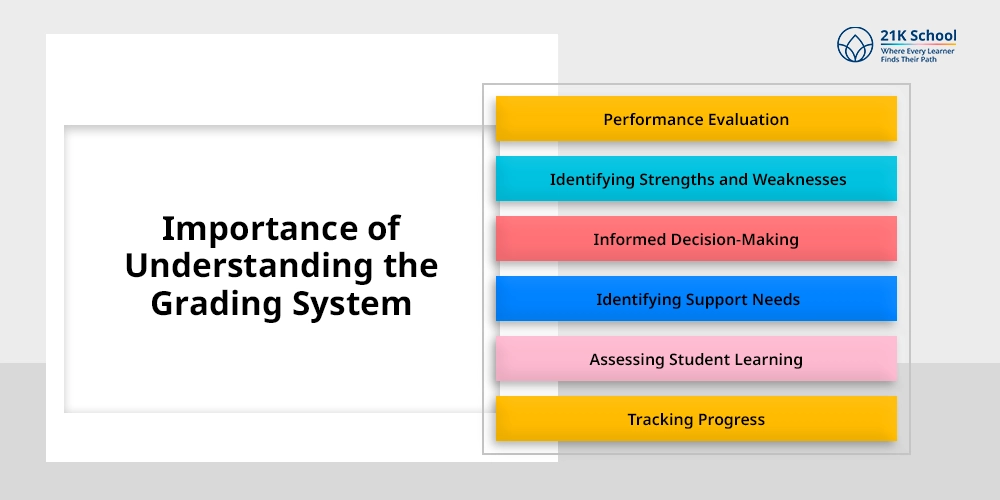
Understanding the grading system is important for learners, facilitators and even parents.
It helps everyone to evaluate academic performance, identify areas for improvement, and make informed decisions about future academic paths.
Grading system allows clear communication of learners’ growth, facilitates goal setting and guides in making decisions about college admissions, scholarships and future job opportunities.
Here’s a essential points to understand the grading system in detail:
1. Performance Evaluation

Grading system is an ideal way for performance evaluation of learners.
It provides a standardized framework for evaluating performance, offering feedback, and facilitating future opportunities.
2. Identifying Strengths and Weaknesses

With the help of a grading system students can identify strengths and weaknesses and word accordingly.
It provides a clear framework for identifying their academics by analyzing each subject, especially those requiring more focus and effort.
3. Informed Decision-Making

Facilitators play a crucial role in learners’ grading systems by making informed decisions for them about curriculum, instruction, and student support. Explore everything about a-Level curriculum.
4. Identifying Support Needs
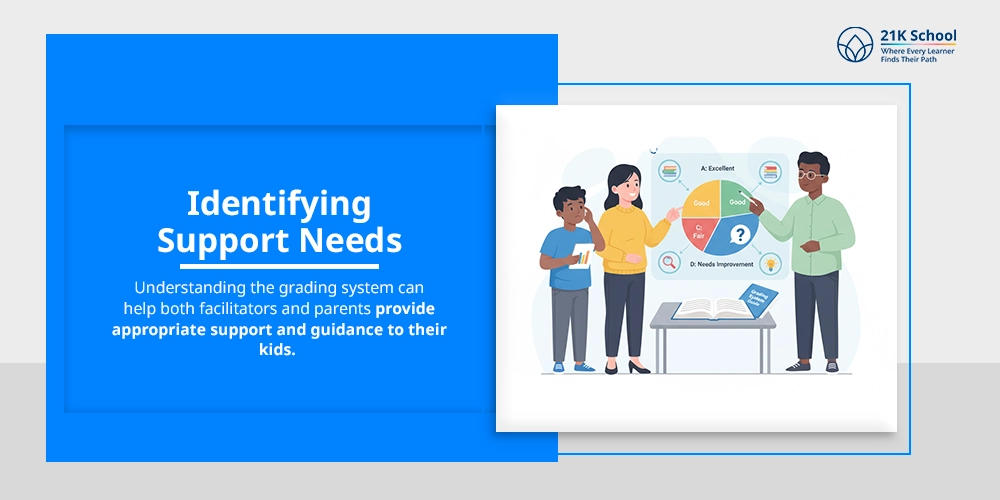
Understanding the grading system can help both facilitators and parents provide appropriate support and guidance to their kids.
5. Assessing Student Learning

Grading also guides facilitators to understand their need for learners ‘ academic achievement.
By assigning the right sort of homework, help in difficult subjects and guiding in interesting activities ensure they shine in the classroom.
6. Tracking Progress

Parents and facilitators can use grades to monitor each kid’s academic progress and identify potential areas of concern. This will ensure future growth and development of learners.
Explore about a-level results day .
Overview of A-Level Grade Scale (A*–E/U)
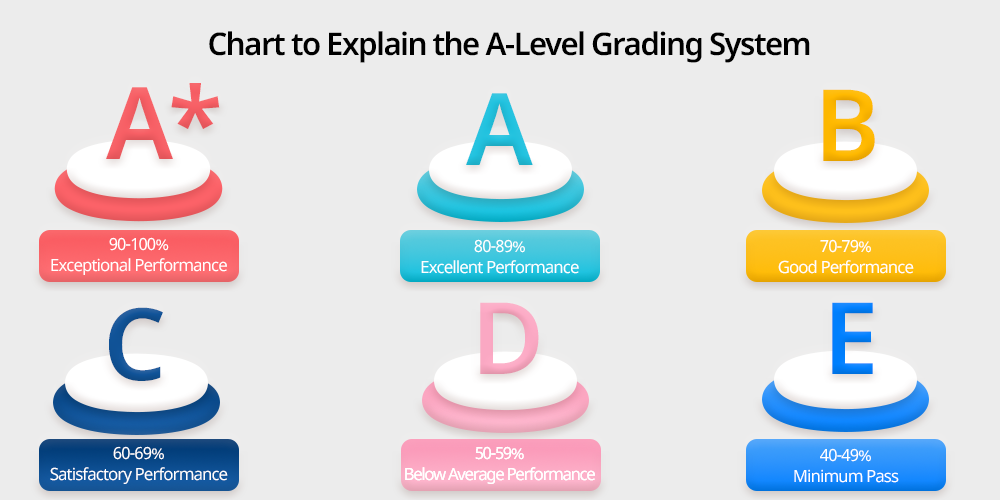
A-Levels are graded on a scale of A* to E, with A* is represented as the highest marks and E being the lowest passing grade.
These grades indicate that a learner has passed the A-Level. However, a grade of U represents failure.
Give a chart to explain the A-Level grading system into this overview of A-Level grade scale:
| S No. | Grade | Description | Status |
| 1. | A* | Highest achievable grade | Pass |
| 2. | A | Excellent | Pass |
| 3. | B | Very good | Pass |
| 4. | C | Good | Pass |
| 5. | D | Satisfactory | Pass |
| 6. | E | Minimal acceptable | Pass |
| 7. | U | Unclassified (below E) | Fail |
Understanding Each Grade
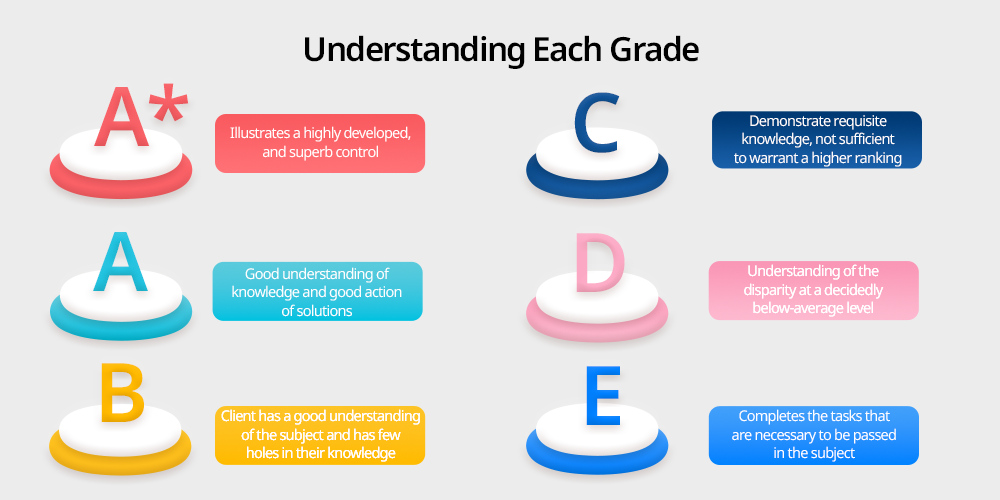
- A* (90-100%): Illustrates a highly developed, and superb control, of the content matter.
- A (80-89%): The test demonstrates a good understanding of knowledge and good action of solutions.
- B (70-79%): Suggests that the client has a good understanding of the subject and has few holes in their knowledge.
- C (60-69%): Demonstrate requisite knowledge which is however not sufficient to warrant a higher ranking in specific areas.
- D (50-59%): It makes the understanding of the disparity at a decidedly below-average level.
- E (40-49%): Completes the tasks that are necessary to be passed in the subject.
A-Level Grades to Percentage Conversion (2025)
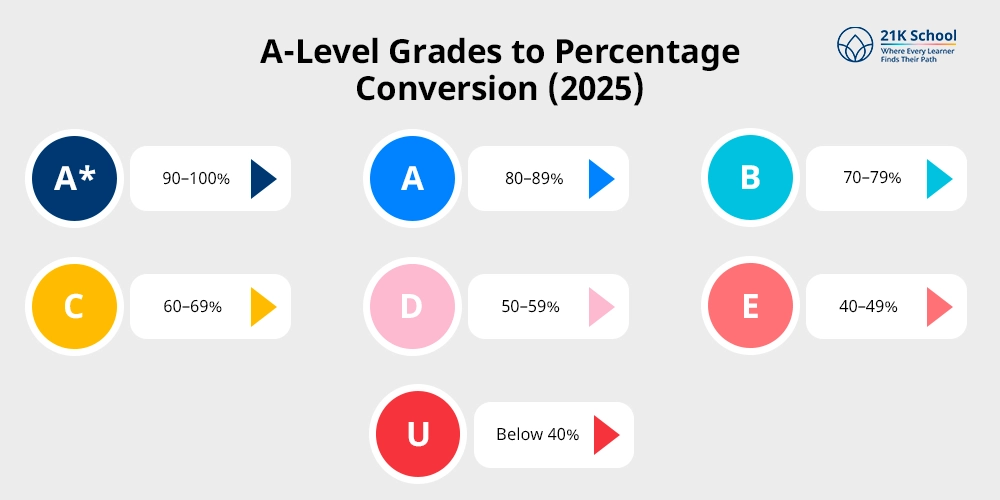
The percentage ranges corresponding to A-Level grades for the year 2025.
| S No. | Grade | Percentage Range (approx.) |
| 1. | A* | 90–100% |
| 2. | A | 80–89% |
| 3. | B | 70–79% |
| 4. | C | 60–69% |
| 5. | D | 50–59% |
| 6. | E | 40–49% |
| 7. | U | Below 40% |
A-Level Grading vs UCAS Tariff Points
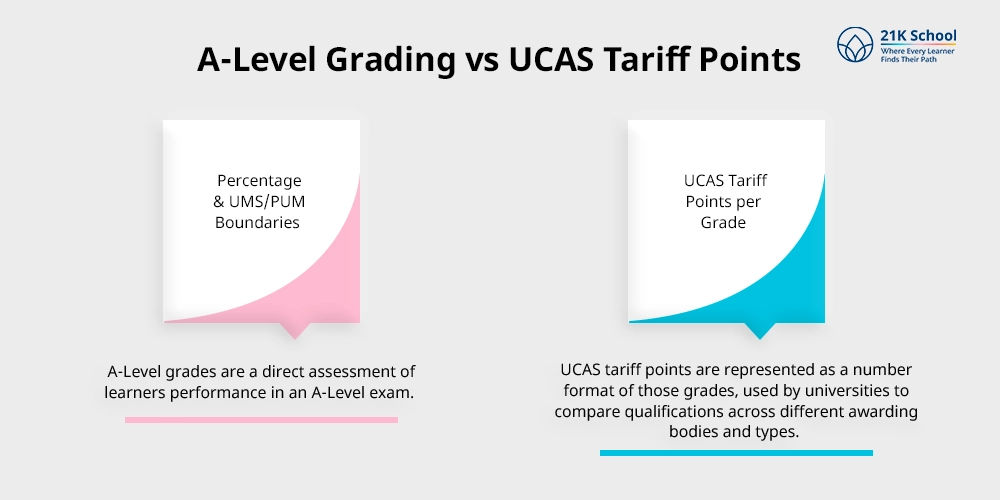
A-Level grades and UCAS tariff points both are related but distinct systems.
In A-Level grades are a direct assessment of learners performance in an A-Level exam.
On the other hand, UCAS tariff points are represented as a number format of those grades, used by universities to compare qualifications across different awarding bodies and types.
For example, an A in A-Level equals 56 UCAS points, while an A is worth 48 points.
1. Percentage & UMS/PUM Boundaries
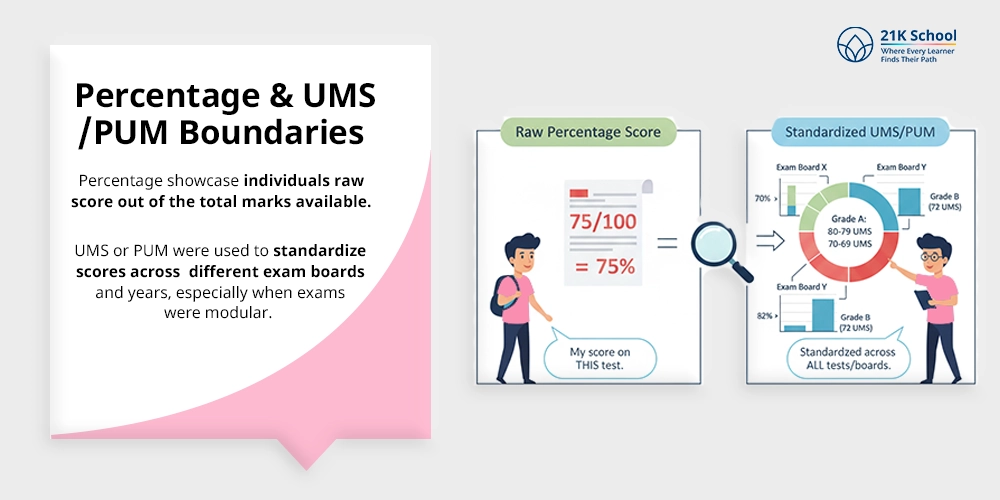
Percentages, UMS (Uniform Mark Scale) and PUM (Percentage Uniform Marks) all comes under the grading system:
Percentage showcase individuals raw score out of the total marks available.
However, UMS or PUM were used to standardize scores across different exam boards and years, especially when exams were modular.
They help in getting a fair grade even if the paper was unusually tough or easy.
For example: An A* usually required 90% or above in PUM while in others it needed around 80%.
Most UK boards now follow linear A-Levels, which don’t use UMS anymore. But Cambridge International still uses PUM scores.
2. UCAS Tariff Points per Grade

Here’s a quick chart showing how A-Level grades convert into UCAS points based on 2025 data:
| S No. | A-Level Grade | UCAS Points |
| 1. | A* | 56 |
| 2. | A | 48 |
| 3. | B | 40 |
| 4. | C | 32 |
| 5. | D | 24 |
| 6. | E | 16 |
| 7. | U | 0 |
Why Scaling Matters ?
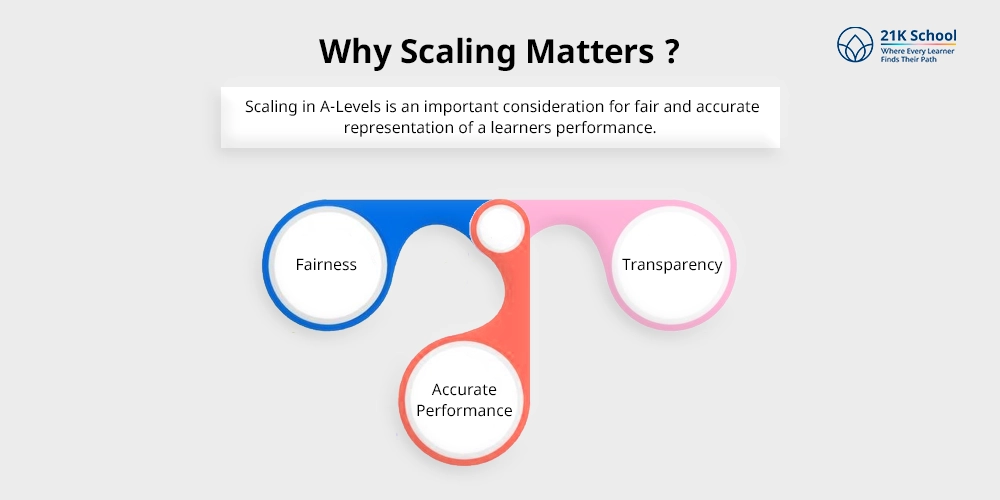
Scaling in A-Levels is an important consideration for fair and accurate representation of a learners performance. It helps in adjusting raw exam scores.
This process adjusts for differences in exam difficulty and considers the performance of the specific group of students taking each subject.
Here’s why scaling matters:
- Fairness: Scaling is an ideal option for differences in exam difficulty, ensuring no student is unfairly disadvantaged.
- Accurate Performance: Representation: Scaling reflects a student’s accurate performance representation, not just the difficulty of a particular exam.
- Transparency: Various popular exam boards like Edexcel and Cambridge publish grade thresholds to maintain transparency in the scaling process.
A-Level Grades vs International Grading Systems
A-Level grades use a letter system (A*-E) where A* is the highest and E is the lowest passing grade.
On the other hand, international grading systems use letter grades (such as the US system, percentage-based systems, or a combination.
Here’s char for more detailed information comparison between with IB, CBSE, and Cambridge IGCSE:
| S.No. | Key Differences: | A-Level Grades | International Grading Systems |
| 1. | Grading Scale: | In A-Levels the use of a letter-based system is preferred (A*-E). | While many international systems use numerical or percentage-based systems. |
| 2. | Pass/Fail Thresholds: | In A-Levels and other systems, you need a certain minimum score to pass. | That minimum score is different depending on the country or school system.For example, in one place you might pass with 40%, while in another you need 50%. |
| 3. | GPA: | A-Levels do not use GPA. Instead, they just report the letter grades for each subject. | The use of GPA is common in many international systems, especially in higher education. |
A-Level Comparison with IB, CBSE, and Cambridge IGCSE
IB, CBSE, and Cambridge IGCSE are prominent educational systems with distinct approaches and have their own benefits for learners.
Here’s a detailed comparison between A-Level, IB CBSE , and Cambridge IGCSE:
| S No. | Qualification | Top Grade | Mid Grade | Failing Grade |
| 1. | A-Level | A* | C | U |
| 2. | IB Diploma Programme | 7 | 4 | Below 4 |
| 3. | CBSE (India) | 100% | 50 to 60 % | Below 33% |
| 4. | IGCSE (Cambridge) | A | C | G/U |
Understand the detailed comparison between igcse vs a-level and a-levels vs ib.
Conclusion
It is important to of the grading system of the A-Levels for one to have a brief understanding of it.
These perceptions are: Grading criteria, assessment of the use of AS Levels and positive study habits enable the students to achieve their intended consequences.
Welcome to 21K School – You are at the right place to learn all about A-Level as well as get the necessary tools and tips to succeed.
Enjoy the process, do not allow yourself to be diverted, and make it a point to go for quality.
Read on to learn more about a-level past papers .


